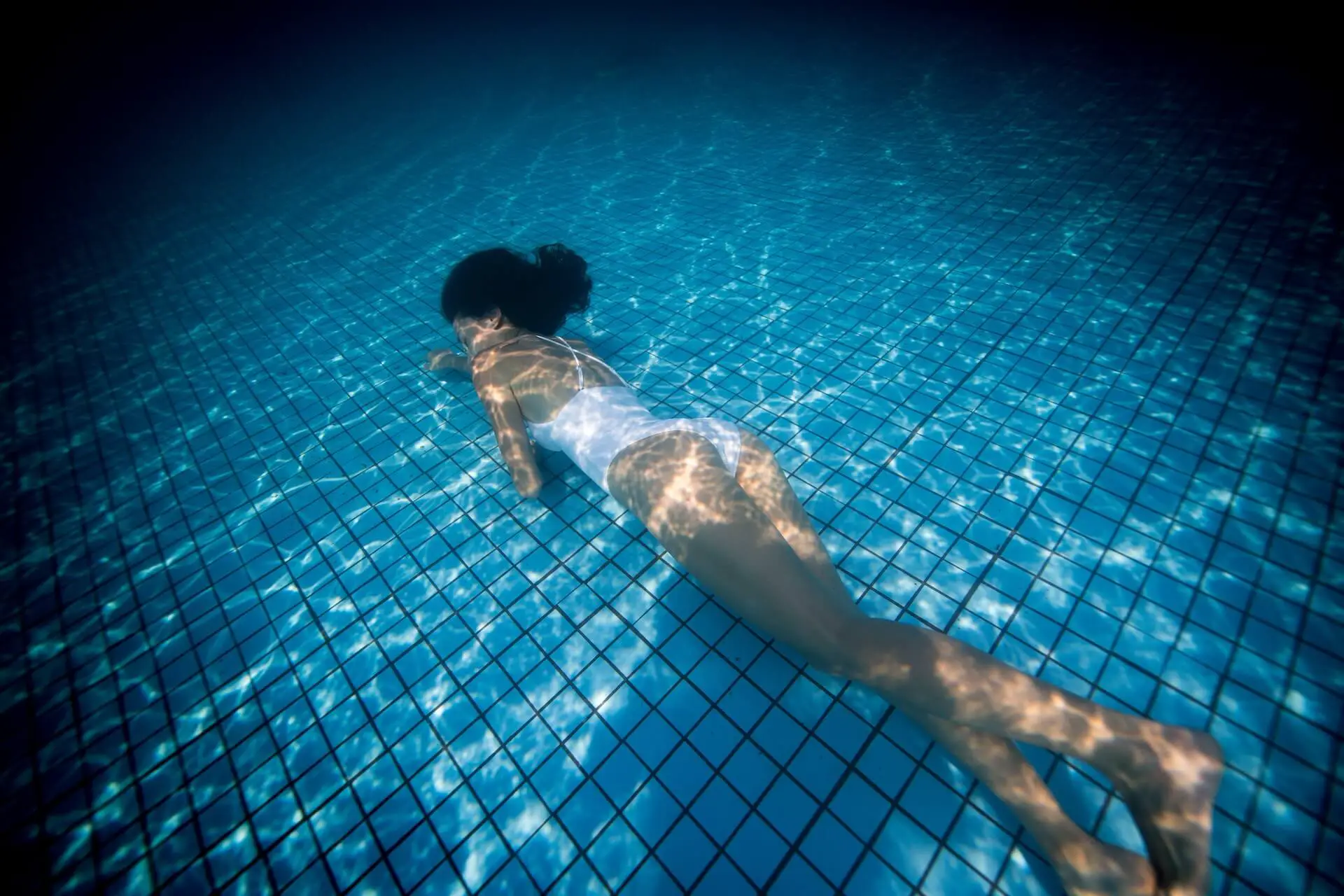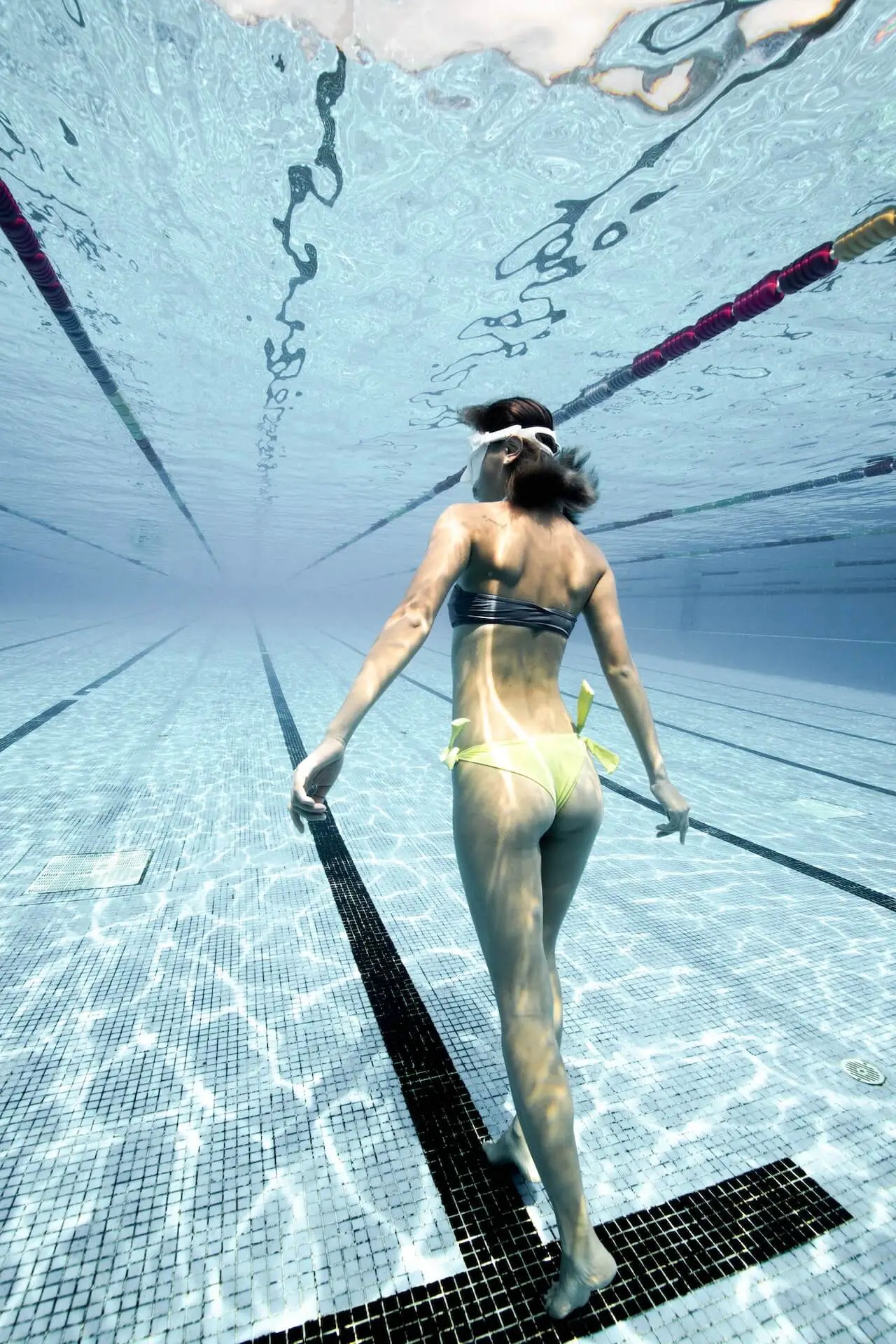Have you ever wondered why some people can float so easily, and why others sink like a rock? To understand this, you need to understand the concept of buoyancy. Specifically, people who have trouble staying afloat have negative buoyancy, meaning they will sink in fluid.
Keep reading on to learn what exactly negative buoyancy is, how it affects you, and how you can continue swimming in spite of it.

Understanding Negative Buoyancy
What is Negative Buoyancy?
There are three types of buoyancy: positive, negative, and neutral. Positive means you float, neutral means you stay suspended at the same depth, and negative means you sink.
Elaborating a bit more on negative buoyancy, it is what occurs when an object, including a person, is denser than the fluid in which it is immersed, causing it to sink.
If you’ve ever felt like you’re sinking in water, you’ve experienced negative buoyancy. This concept is important to understand, as it plays a crucial role in various water-based activities, safety measures, and can affect your swimming experience in general.
Common Causes of Negative Buoyancy
Now you might ask, under what conditions does negative buoyancy happen? A number of factors contribute to whether someone is negatively buoyant in water.
For instance, your body composition, lung capacity, and swimming/scuba equipment can all impact your buoyancy. Also, the water’s temperature and salinity can affect your body’s ability to float.
We’ll talk about these in more detail below, but you should be aware of these factors and learn how to manage negative buoyancy when engaging in water sports or even leisurely swimming activities.
The Science Behind Buoyancy
If you’re curious about how negative buoyancy occurs, you must first understand the physical laws that govern it, particularly Archimedes’ Principle.
This principle states that the upward buoyant force on an object, like your body in water, is equal to the weight of the fluid that the object displaces.
In simpler terms, the force that pushes you up in water (the buoyant force) is dependent on both the volume that your body takes up in water and the force of gravity acting on you.
Generally, positive buoyancy (floating) is when the upward buoyant force is greater than the downward gravitational force. On the other hand, negative buoyancy occurs when the gravitational force is stronger, causing you to sink.
The Role of Density and Volume in Buoyancy
Relationship Between Density, Volume, and Buoyancy
When you swim, your body’s buoyancy plays a crucial role in determining whether you float or sink. Buoyancy is the upward force that opposes the weight of an object submerged in a fluid (like your body in water).
The buoyant force depends on the density and volume of the fluid as well as the object’s density. In simple terms, density is mass divided by volume; thus, an object with a higher density than the fluid will sink, while those with lower density will float.
Comparing Density of Water, Air and the Human Body
Let’s compare the densities of different materials to understand how buoyancy works:
- Water: The density of water is typically about 1,000 kg/m³, depending on the temperature and salinity. When you’re in water, your body’s volume displaces an equal volume of water, generating buoyant force.
- Air: The density of air is much lower than water, at around 1.2 kg/m³. Thus, the buoyant force in air is much weaker for a human body compared to water.
- Human Body: Your body is mainly composed of water, fat, muscle, bones, and other tissues. Fat is generally less dense than water (about 900 kg/m³), while muscles and bones have a higher density (1,100-1,800 kg/m³). Your overall body density depends on the distribution of these components.
The proportion of fat, muscle, and lung capacity in your body will affect your buoyancy. Fat allows you to float, while muscle mass will make you sink more easily. A greater lung capacity provides additional buoyancy due to the air you hold in your lungs.
By consciously controlling your body’s composition and lung capacity, you can manage your buoyancy while swimming.
Negative Buoyancy in Nature
In nature, many animals have developed ways to manage buoyancy for their survival. In this section, we’ll take a look at some of these creatures and how they utilize negative buoyancy to their advantage. Remember, negative buoyancy occurs when an object is denser than the fluid it displaces, causing it to sink.
Whales:
You might be surprised to learn that one of the largest animals on the planet, whales, are also masters of negative buoyancy. They dive deep into the ocean to feed on prey and communicate with other members of their pod.
To achieve this, they compress their lungs, reducing the volume of air inside and thus making them negatively buoyant. This allows them to easily dive to great depths without expending much energy.
Sharks:
Fish also use negative buoyancy to navigate their underwater world. While many fish have a specialized organ called a swim bladder that helps them maintain neutral buoyancy, some fish, like sharks and some deep-sea species, do not have this organ. Instead, they rely on negative buoyancy to stay submerged while they search for food and escape predators.
They manage their buoyancy by adjusting the amount of water in their bodies and manipulating their fins. For instance, some sharks maintain negative buoyancy by constantly swimming or using their oily livers to generate some buoyant force.
Deep Sea Fish:
Deep-sea fish often have mineral-rich bones that make them denser and more negatively buoyant, allowing them to stay at depths where the pressure is immense, and few other creatures can survive.
While negative buoyancy might make it challenging to stay afloat for animals like humans, it’s a useful adaptation for many creatures in the natural world. From the colossal whales to the deep-sea fish, these animals show us that, with a little help from nature, it’s indeed possible to swim with negative buoyancy!
Swimming with Negative Buoyancy

So if you are negatively buoyant, does that mean you cannot swim? Not true.
Here are some techniques that could be used to swim under conditions of negative buoyancy:
- Sculling: This is a technique where you move your hands in a figure-8 motion to generate lift, similar to how birds and insects use their wings to fly. Sculling can be done in a number of positions, including on your back, on your front, and upright.
- Treading Water: This involves moving your legs in a scissor-like or eggbeater motion while sculling with your hands. Treading water is more tiring than sculling but can be useful if you need to stay in one place.
- Swimming: Regular swimming strokes, like the crawl, breaststroke, butterfly, and backstroke, can be used to swim with negative buoyancy. It will be more difficult than normal, however, because you’ll have to work against the force pulling you down. You will also likely sink whenever you stop swimming.
- Use of Fins: Using fins can provide extra propulsion which can be beneficial to overcome negative buoyancy.
- Flotation Devices: From a snorkel vest, life vest, and swim belt, to swimming with a kickboard, or even just relying on a wetsuit for extra buoyancy, there are many pieces of gear that can help you stay afloat in the water.
- Proper Breathing Technique: Taking in air will help you become less negatively buoyant. Conversely, exhaling a lot of air will make you more negatively buoyant. You can control your depth by controlling your breath; take deep breaths and hold it if you want to float.
- Diving Weights: If you are diving and intentionally want to maintain negative buoyancy (for example, to explore the bottom of a body of water), you can use diving weights. This is a common practice in scuba diving. Divers use weights to help them descend, but they also use buoyancy control devices that can be filled with air to counteract the weights and achieve neutral buoyancy, or even positive buoyancy when needed.
Negative Buoyancy in Scuba Diving
In scuba diving, negative buoyancy is what allows a diver to descend below the surface and explore underwater environments.
When you start a dive, you usually want to be negatively buoyant to some degree. This is why divers wear weights: to counteract the positive buoyancy provided by their bodies and their equipment, such as wetsuits and buoyancy control devices (BCDs), and allow them to sink.
However, too much negative buoyancy can be dangerous, as it can cause a diver to descend too quickly, potentially leading to injuries or increasing the risk of decompression sickness (also known as “the bends”). That’s why divers use their BCDs to fine-tune their buoyancy underwater. By adding or releasing air from the BCD, divers can achieve neutral buoyancy—where they neither sink nor float—which is ideal for exploring underwater without exerting unnecessary energy.
Conversely, as divers ascend, they must also be cautious to manage their buoyancy correctly. The pressure decreases as you ascend, which causes the air in your BCD and your body to expand. This expansion results in increased positive buoyancy, causing you to ascend faster. To control this, divers usually release air from their BCDs as they ascend to maintain neutral buoyancy.
As you can see, buoyancy is a fascinating topic and there are many practical examples of it not just in water sport activities, but also in nature. By understanding how it works, you can better understand how to maneuver your body in the water so that you can get to where you need to, whether that’s to stay at the surface or to dive to the depths below.
Sources:
- https://www.khanacademy.org/science/physics/fluids/buoyant-force-and-archimedes-principle/a/buoyant-force-and-archimedes-principle-article
- https://beginnertriathlete.com/cms/article-detail.asp?articleid=2641
- https://weswim.club/swimming-technique-tip-buoyancy/
- https://www.ncbi.nlm.nih.gov/books/NBK470245/

